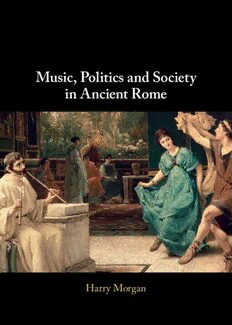
Music, Politics and Society in Ancient Rome PDF
Preview Music, Politics and Society in Ancient Rome
Music, Politics and Society in Ancient Rome Musicwaseverywhere in ancient Rome.Wherever onewentin thesprawling city,thesoundofsingingandpiping,drummingandstrummingwasneverfar out of earshot. This book examines the role of music in Roman politics and society, focusing on the period from the Roman conquest of Greece in the second century BCE to the end of the reign of Nero in 68 CE. Drawing on a widerangeofliterarytexts,inscriptionsandmaterialartefacts,HarryMorgan uncoversthetensionsbetweeneliteandpopularattitudestowardsmusic,and showshowmusicwasexploitedasatoolbypoliticalleadersandemperors.Far from being a marginal aspect of daily life, music was fundamental to Roman political culture and social relations, shaping debates about class, gender and ethnicity.Thebookwillbeofinteresttostudentsandscholarsofancientmusic and Roman history. isa lecturer in AncientHistoryat Harvard University. Published online by Cambridge University Press Published online by Cambridge University Press Music, Politics and Society in Ancient Rome HarvardUniversity Published online by Cambridge University Press ShaftesburyRoad,CambridgeCB28EA,UnitedKingdom OneLibertyPlaza,20thFloor,NewYork,NY10006,USA 477WilliamstownRoad,PortMelbourne,VIC3207,Australia 314–321,3rdFloor,Plot3,SplendorForum,JasolaDistrictCentre,NewDelhi–110025,India 103PenangRoad,#05-06/07,VisioncrestCommercial,Singapore238467 CambridgeUniversityPressispartofCambridgeUniversityPress&Assessment, adepartmentoftheUniversityofCambridge. WesharetheUniversity’smissiontocontributetosocietythroughthepursuitof education,learningandresearchatthehighestinternationallevelsofexcellence. www.cambridge.org Informationonthistitle:www.cambridge.org/9781009232333 DOI:10.1017/9781009232326 ©HarryMorgan2023 Thispublicationisincopyright.Subjecttostatutoryexceptionandtotheprovisions ofrelevantcollectivelicensingagreements,noreproductionofanypartmaytakeplace withoutthewrittenpermissionofCambridgeUniversityPress. Firstpublished2023 AcataloguerecordforthispublicationisavailablefromtheBritishLibrary. LibraryofCongressCataloging-in-PublicationData Names:Morgan,Harry(Historian)author. Title:Music,politicsandsocietyinancientRome/HarryMorgan. Description:[1.]|NewYork,NY:CambridgeUniversityPress,2022.|Includesbibliographicalreferencesandindex. Identifiers:LCCN2022036811(print)|LCCN2022036812(ebook)|ISBN9781009232333(hardback)| ISBN9781009232319(paperback)|ISBN9781009232326(epub) Subjects:LCSH:Music,GreekandRoman–Historyandcriticism.|Music–Politicalaspects–Rome–History–To476.| Music–Socialaspects–Rome–History–To476. Classification:LCCML169.M872022 (print)|LCCML169 (ebook)|DDC780.937–dc23/eng/20220802 LCrecordavailableathttps://lccn.loc.gov/2022036811 LCebookrecordavailableathttps://lccn.loc.gov/2022036812 ISBN978-1-009-23233-3Hardback CambridgeUniversityPress&Assessmenthasnoresponsibilityforthepersistence oraccuracyofURLsforexternalorthird-partyinternetwebsitesreferredtointhispublication anddoesnotguaranteethatanycontentonsuchwebsitesis,orwillremain,accurateorappropriate. Published online by Cambridge University Press Contents List of Figures [page vii] Acknowledgements [x] List of Abbreviations [xii] Introduction [1] ApproachingRomanMusic [3] SourcesofEvidence [6] Terminology [11] GreekandEtruscanInfluencesonRomanMusic [18] Sound,SpaceandSocialControl [26] SensingMusic,EmbodyingMusic [30] TheStatusofMusicians [34] ChapterOutline [39] 1 The Games of L. Anicius Gallus and the Cultural Politics of Music in the Second Century BCE [42] TriumphalPoliticsandSpectacleCultureinMid-RepublicanRome [49] BattleoftheBands:Anicius’MartialSoundtrack [55] MusicandMoralityinPolybius’Histories [62] Scipio,CatoandtheRomanOppositiontoGreekMusic [72] BanningtheLudusTalarius:ACaseofRomanMusicalCensorship? [77] Conclusion [81] 2 Popular Music and Popular Politics in the Late Republic [83] CiceroontheMusicoftheRomanTheatre [86] TheMusicalExperienceofPompey’sTheatre [98] TheRoleofMusicinLate-RepublicanOratoryand RhetoricalInvective [104] GaiusGracchusandtheFistula [110] PubliusClodius:Harpist,Chorus-Leader,EntertainerExtraordinaire [115] NecTamMusicus:Piso,PhilodemusandtheEpicureans [122] TheOnosLyras:Varro’sSatireonMusic [129] Conclusion [139] 3 Augustus, Apollo’s Lyre and the Harmony of the Principate [142] ApolloCitharoedusonthePalatine [144] ApolloCitharoedusandtheCommemorationofActium [153] v Published online by Cambridge University Press vi Contents Antony,CleopatraandtheTriumphoverDionysianMusic [160] TuningtheWorld [173] Sound,RitualandtheCitharodicExperience [178] A‘GoldenAge’ofMusic? [184] Conclusion [189] 4 Nero and the Age of Musomania [191] ‘OApollo,OAugustus’:MakingSenseofaMusicalEmperor [198] TheMaster’sSongbook:NeronianaCanticaandPopularMusic atRome [206] Water-Organs,BagpipesandtheLureoftheArena [215] MusomaniainaYoungMan’sWorld [224] Conclusion [238] Epilogue [239] Bibliography [249] Index [279] Published online by Cambridge University Press Figures 0.1 MosaicpanelbyDioscuridesofSamosshowingmaskedactorsplaying musical instruments (tibiae, cymbala and tympanum). Based on an episodefromMenander’sTheophoroumene.FromtheVillaofCicero, Pompeii; ca. 100 BCE. [page 7] 0.2 Facsimile of a Roman cornu found at Pompeii, produced by the Belgian instrument-maker Victor-Charles Mahillon (1841–1924). [10] 0.3 Pair of bronze cymbals linked by a chain; Pompeii, first century CE. [10] 0.4 Roman sistrum, made of bronze or copper alloy; first or second century CE. [11] 0.5 Performancebythegroup‘LudiScaenici’attheFestivalTarracoViva; Tarragona, Spain. [12] 0.6 AtibiafromRomanSyria,madeofbonewithbronzeandsilverfacing 1 and decorative chalcedony bulb, L. 23/8 in. (58.6 cm); ca. 1–500 CE. [16] 0.7 Detailofmosaicpanelshowingadancerandtibiaplayer.Oneoffive panelswithcircusandarenascenes,fromSta.SabinaontheAventine, Rome; third century CE. [16] 0.8 WallpaintingfromHerculaneumdepictingaceremonyofthecultof Isis. A figure in a mask performs a sacred dance, accompanied by a female tympanum-player dressed in white, who stands behind him, and a throng of attendants with sistra; ca. 1–79 CE. [19] 0.9 Wallpaintingwithseatedwomanholdingacithara,fromRoomHof the Villa of P. Fannius Synistor at Boscoreale; ca. 50–40 BCE. [25] 0.10 Marble funerary relief depicting a priest of Cybele with cymbala, tympanumandPhrygiantibia;fromLavinium,Rome;ca.mid-second century CE. [34] 1.1 Bas-relief from Osuna (Urso), Spain, representing a cornicen; early first century BCE. [57] 1.2 Marble bas-relief showing musicians and armed dancers leading captives in a triumph or ovation; mid-first century BCE. [59] vii Published online by Cambridge University Press viii Listof Figures 2.1 3-D model of the Theatre of Pompey, general view, looking southeast. [99] 2.2 3-DmodeloftheTheatreofPompey,viewofstageandcavea. [100] 2.3 Wall painting depicting a musical concert; Herculaneum, Italy, ca. 1–79 CE. [108] 2.4 Wall painting depicting Pygmies at an outdoor banquet. A seated tibicen playing a Phrygian pipe accompanies scenes of sex and drinking. From the House of the Doctor, Pompeii, ca. 59–79 CE. [109] 3.1 Terracotta plaque from the sanctuary of Apollo on the Palatine, showing Apollo and Diana adorning a sacred pillar; ca. 30 BCE. [148] 3.2 Apollo, Diana and Latona received by Victoria on the Palatine; Augustan marble relief. [149] 3.3 Apollo, Diana and Latona on the Sorrento Base; Augustan/early imperial period. Sorrento. [150] 3.4 Apollo with cithara and quiver depicted on a fragment of a wall painting from the House of Augustus. [151] 3.5 Marble statue of Augustus from Prima Porta; after a bronze original, ca. 20 BCE. [152] 3.6 Apollo Citharoedus overlooking the Battle of Actium; Medinaceli Reliefs, detail of panel; second quarter of first century CE. [156] 3.7 Denarius struck by C. Antistius Vetus, 16 BCE, Rome mint. Obverse: head of Augustus. Reverse: Apollo with lyre in left hand and patera in right hand, pouring a libation over an altar. [157] 3.8 Aureus of Augustus, 15–13 BCE, Lugdunum mint. Observe: head of Augustus. Reverse: Apollo with plectrum in right hand and lyre in left hand. [158] 3.9 Aureus of Augustus, 11–10 BCE, Lugdunum mint. Observe: head of Augustus,laureate.Reverse:Apollowithpaterainrighthandandlyre in left hand. [159] 3.10 Wall painting illustrating the musical contest between Apollo and Marsyas; from Herculaneum, 60–79 CE. [162] 3.11 Bronze as of Domitian, 88 CE. Rome mint. Observe: head of Domitian,laureate.Reverse:Domitiansacrificesoveranaltarinfront of a temple, accompanied by a tibicen and fidicen. [183] 4.1 Poster for the silent motion picture Quo Vadis (1913) showing Nero fiddling while Rome burns. [193] Published online by Cambridge University Press List of Figures ix 4.2 Bronze as of Nero, 62–68 CE. Rome mint. Observe: head of Nero, radiate. Reverse: (Nero as?) Apollo Citharoedus, singing and playing cithara. [204] 4.3 Medalliondepictinganorganistandcornicenonamphitheatremosaic from Roman villa at Nennig, near Trier, Germany; second or third century CE. [220] 4.4 Copperalloycontorniate,mintedinRome,latefourthorfifthcentury CE.Observe:headofNero,laureate,withpalm-branchcountermark. Reverse: hydraulis with a figure standing facing on the left, with legend LAVRENTI NICA (the victory of Laurentius). [221] 4.5 Terracotta figurine from Alexandria, Egypt, ca. 200 CE, showing a pair of musicians. [223] 4.6 TerracottafigurinefromAlexandria,Egypt,firstcenturyCE,showing a female organ-player wearing a diadem and a macrophallic dwarf playing the tuba. [224] 4.7 Wallpainting ofa banquetscene,from Room15of theHouseof the Triclinium, Pompeii (V.2.4). [231] 4.8 Wallpainting ofa banquetscene,from Room15of theHouseof the Triclinium, Pompeii (V.2.4). [232] Published online by Cambridge University Press
